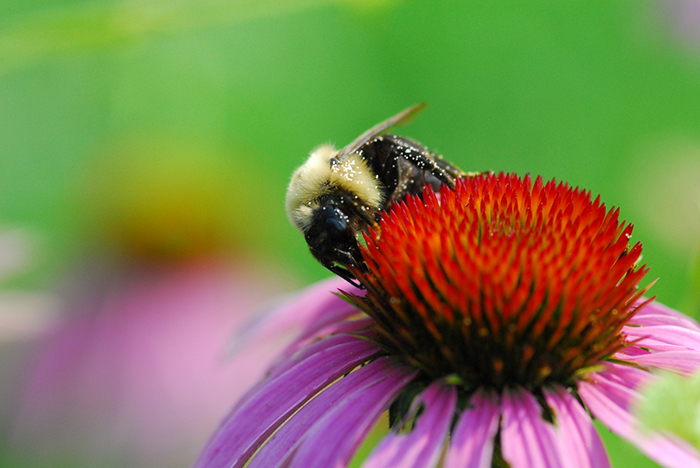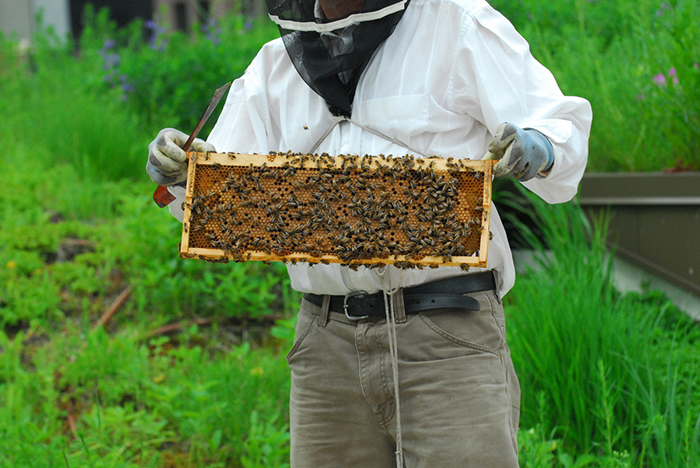National Pollinator Garden Network Launches Plan to Protect Butterflies and Honey Bees
Dozens of conservation and gardening organizations joined together today to form the National Pollinator Garden Network and launch a new nationwide campaign to reach the goal of one million additional pollinator gardens by the end of 2016.
The National Pollinator Garden Network collectively represents nearly one million active gardeners and 15,000 school gardens. The Network will work to provide resources for individuals, community groups, government agencies and the garden industry to create more pollinator habitat through sustainable gardening practices and conservation efforts.
The White House released the National Strategy to Promote Health of Honey Bees and Other Pollinators. Pollinators are critical to the Nation’s economy, food security, and environmental health. Honey bee pollination alone adds more than $15 billion in value to agricultural crops each year, and helps ensure that our diets include ample fruits, nuts, and vegetables. This tremendously valuable service is provided to society by honey bees, native bees and other insect pollinators, birds, and bats.
Edible magazines have been reporting on this crisis for years. Learn more about the role pollinators play within our ecosystem and what can be done below.

Save Our Pollinators
Photographer and activist Michelle Magdalena has neonicotinoid insecticides in her crosshairs. Her latest project, Save Our Pollinators, is a natural marriage of her intense opposition to pesticides and GMOs, and the desire to mobilize public opinion in her local community towards influencing legislation. Specifically, the Pacific Grove-based artist is asking: How do we help, sustain, and protect monarchs, bees, and other pollinators? Read the story at Edible Monterey Bay.
A Bee Walks Into a Bar
Next time you have a cocktail, remember the pollinators Without bees, would a mixologist have a job? These wonderful pollinators give a spirit verve and make a cocktail a “cocktail.” Even the shapes of the glass and colors of the drink resemble flowers, drawing humans to the elixir like bees to nectar. Read the story at Edible East End.

A Plea for the Bees: Protect our Pollinators
With some land management, we can help wild bee populations thrive so they can pollinate, and sustain, our crops. Here is what you can do on your own property. Read the story at Edible Long Island.
Planting for Honeybee Pollination
A world without honeybees would be a world without many of the foods we expect to see at our local farmers’ markets each week. Hundreds of crops, including fruits, vegetables, nuts, seeds, spices, herbs, and edible flowers require honeybee pollination. Read the story at Edible Nutmeg.
Use the S.H.A.R.E. map to register your pollinator habitat below. It's free and easy! Explore other pollinator friendly SHARE landscapes all over the globe! The organization’s logos shown are registering their pollinator habitat on the map, too. Be a part of the movement now!
Honey, Don’t Forget the Pollinators: The pivotal role of Baja Arizona foodscapes in bee and butterfly recovery
Go to the produce section in any Whole Foods, AJ’s, or Sprouts in the Tucson area, and at least 237 of the 453 fruits and vegetables found there were brought to you by a now-imperiled fleet of flying pollinators. While scientists and farmers in Baja Arizona were among the first in the country to sound the alarm about pollinator declines, they are also leading the way in on-farm pollinator recovery that may ultimately ensure our own food security. Read the story at Edible Baja Arizona.
What Our Bees Bring Home
In Northern California's Marin County local beekeepers have their marching orders: Their goal is to develop resistant traits in bees that can replace chemical treatment of bee maladies. Read the story at Edible Marin & Wine Country.

Surprisingly, just keeping a hive doesn’t take much space. In fact, it doesn’t take anymore than the footprint of the hive itself, roughly 16 x 22 inches. From there, the hives build up. “You could keep a colony of bees on your balcony. Read the story at Edible Piedmont.
The Royal Couple of Beekeeping
2004–2005 was the year that the as-yet-unexplained Colony Collapse Disorder (CCD) among bee hives began to peak. At the same time, the local food movement had gained momentum, and the plight of bees, which make up 80% of all pollinator insects, was coming into greater public consciousness. Read the story at Edible Marin and Wine Country.




